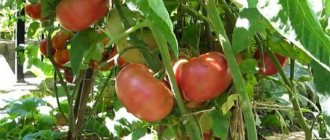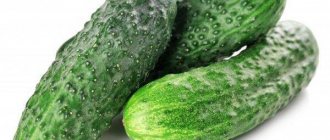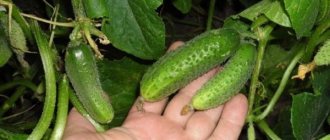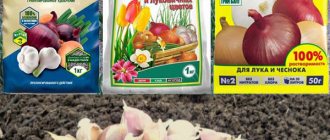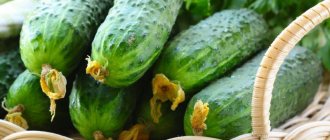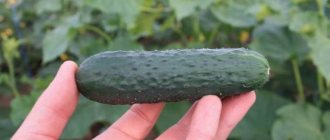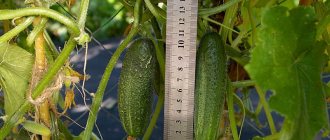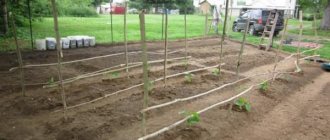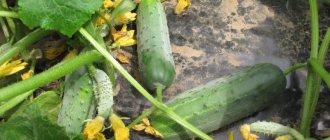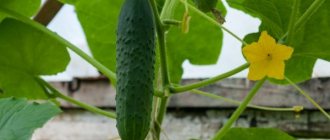Cucumber Mels F1 is one of the hybrids with high yields. With proper care, you can get a record number of greens. Coupled with self-pollination and the ability to grow the hybrid in greenhouses, this makes it one of the best for both sale and personal consumption.
| Landing location | Ripening time | Mode of application | Fruit length | Group | Fruit smoothness | Pollination method |
| Universal | Early ripening (35-45 days) | Universal | Short (gherkins) - less than 10 cm | Hybrid | Highly lumpy | Parthenocarpic |
Description of the variety
Mels F1 cucumbers are a hybrid bunch variety that has gained great popularity among gardeners. It is distinguished by its ultra-early ripening period, allowing harvesting already on the 35th day after the sprouts appear. The variety is parthenocarpic and self-pollinating, intended for cultivation both in open ground and in greenhouses.
This variety differs from the others in the large number of fruits set on vines. Thus, 4-6 ovaries can form on one node. The greens themselves have lumpy skin with white spines and light pubescence. On average, the length of the fruit is no more than 10 cm. The pulp is light green, juicy and crisp, without the presence of bitterness.
Advice! For better fruit ripening, it is recommended to cut off the lower 3-4 shoots.
Advantages and disadvantages
In addition to presentation, Mels F1 cucumbers have a number of other advantages:
- Excellent taste of the fruit.
- Universal scope of application.
- Ultra-early ripening.
- High yields.
- Resistance to powdery mildew, POM and other dangerous diseases of cucumbers.
- Formation of a large number of ovaries.
- Easy to care for.
Sowing seeds
Cucumber "Mels f1" seeds are sown at the end of May according to a 60x15 cm pattern or in a nesting method according to a 70x70 cm pattern, taking into account a number of the following recommendations:
- sowing on warm ridges under film cover is carried out with soaked seeds no earlier than the last ten days of May;
- without the use of film cover, soaked seeds are sown at the very beginning of June;
- the soil on the ridges must be fully prepared, fertilized and disinfected with special means;
- seeds should not be buried more than 2.0-2.5 cm, because Significant deepening can delay the emergence of seedlings.
Cucumbers should be sown in ridges located in a well-lit area, with sufficiently drained and warm soil with a pH level of 6-7. As a rule, when growing this hybrid form, there are no problems with germination, and seedlings appear on the third day.
Features of cultivation
This crop can be grown in two ways: seedlings and seeds.
Sowing seeds
Before sowing seeds, it is necessary to prepare the soil for planting in advance. To do this, the chosen place is well dug up and fertilized. Humus, wood ash or bird droppings are good options for feeding. The seeds themselves can be pre-soaked in a weak solution of potassium permanganate.
It is better to plant seeds in well-warmed soil, approximately in the second half of May. The pattern can be used 60*15 cm or 70*70 cm. When planting, you should follow the following recommendations:
- The seeds are sown under a film cover, which will protect them from night frosts and provide comfortable conditions.
- Seeds are sown no deeper than 2.5-3 cm, since their deeper location can delay their germination too much.
- After planting, the soil is mulched with straw or pine needles.
Seedling method
To bring the harvest closer, it is better to use the seedling method of growing crops. To obtain high-quality healthy seedlings, seeds are sown by the end of March using the following technology:
- Growing seedlings is possible at home, as well as in greenhouses made of polycarbonate or glass.
- Good seedlings are obtained by planting seeds in special peat containers.
- A ready-made mixture for vegetable crops is suitable as a soil.
- You can accelerate the growth of seed germination by watering with biological growth enhancers.
- Before emergence, it is advisable to cover the containers with a layer of polyethylene.
- The frequency of watering seedlings depends on the drying speed of the upper layers of the soil mixture.
- Optimal conditions for growing are temperatures from 250C.
It is recommended to plant seedlings in a permanent place after hardening them. To do this, the seedlings are taken to a cool room. At first, this procedure is carried out for 5 minutes, increasing the time over time.
Landing
Seed method
Seeds can be sown in open ground no earlier than the end of May, in a greenhouse - in mid-May, if the weather is warm enough. The soil should be no colder than 15 degrees at a depth of about 12 cm.
The area for sowing is prepared in the fall. The garden is carefully dug up, incorporating compost or manure into the soil (a bucket for every square meter). Select beds where nightshade crops (potatoes, peppers, tomatoes) or cabbage, as well as legumes, were previously grown. The place should be sunny and protected from strong winds.
Before sowing, you should measure the acidity of the soil. If the pH value exceeds 6-7, add slaked lime, chalk, ash or dolomite flour.
After sowing the seeds into the holes, cover them with film until sprouts appear, then remove it.
Seedling method
To plant plants in a greenhouse, seeds are planted into seedlings at the beginning of April or even at the end of March.
Seedlings need to be grown for 25-30 days in peat pots and light nutritious soil. The temperature is maintained at +18-20. You can feed the seedlings if necessary, but excess fertilizer at this stage can lead to a complete absence of fruits in the future.
Seedlings with 3-4 leaves are transferred to the ground.
For 1 sq. m place no more than 2 plants, since they are very spreading and require space.
Caring for Mels F1 cucumbers
Caring for this hybrid variety is not much different from caring for cucumbers. So the main care measures are the formation of the plant stem, regular watering and fertilization.
Plant Formation
Mels F1 cucumber should grow in one stem. With the command of the first adult leaves, it is necessary to remove excess shoots and stepsons. Due to the fact that a huge number of ovaries are formed on the plant, in order to avoid damage to the stem, the crop should be harvested every day.
Watering
Before the first fruits appear on the plant, the beds should be watered 2-3 times a week. The optimal volume of water per 1 m2 is 4-5 liters. If the bushes have been mulched, then the watering procedure should be done through this mulch.
After the first harvest of gherkins is harvested, experienced gardeners recommend watering the cucumbers more intensively and using warm water. The procedure should be performed strictly at the root, without affecting the leaves and stem of the plant.
Fertilizer application
After the first harvest, the plants need to be fed. Rotted manure or wood ash can be used for this purpose. If everything is clear with the first option, then before adding ash you need to prepare a special solution. It involves thoroughly stirring 10-12 tbsp. l. ash per 5 liters of water. This mixture should be stirred regularly throughout the week for better dissolution. Cucumber beds are fertilized with the prepared infusion 2 times a month.
Seedling method
To obtain earlier production, “Mels-f1” cucumbers should be grown in seedlings. To obtain strong and high-quality seedlings, seeds must be sown in late March - early April, adhering to the following technology:
- seedlings can be grown in glass or polycarbonate greenhouses, as well as at home;
- the optimal result is achieved when growing cucumber seedlings in special peat pots or cassettes;
- to fill the pots, you can use a ready-made soil mixture suitable for growing vegetables, or a self-made soil substrate;
- Sprinkling the soil with special growth stimulants, which can be used as biological agents, has a good effect;
- at first, before the seedlings’ loops appear, the seedling containers are covered with translucent material to maintain moisture;
- watering is carried out as the top layer of soil dries;
- the temperature regime, which in the first days should be at least 25°C, after opening the cotyledon leaves, should be lowered by 5°C.
Planting of seedlings is carried out with preliminary hardening procedures, with preference given to the morning hours. When replanting, you need to be very careful and attentive so as not to damage the delicate root system of the plant.
Seedlings should be placed with a distance of 90 cm in a row and approximately 1.20-1.5 m between rows, which will ensure full development of the plants and make them easier to care for. Rare planting is due to the power of the plants.
Diseases and pests
Despite the fact that cucumbers of the Mels F1 variety have good immunity to olive spot, powdery mildew and mosaic, it is recommended to carry out a number of preventive measures. To better preserve the crop, you should regularly ventilate the greenhouse and control the humidity level in it.
Improper crop care can lead to root rot. You can get rid of it using a solution of brilliant green. To prepare it, you will need to add 20 drops of this substance to 10 liters of water and water the affected plants with the resulting solution.
A solution based on 10 liters of water, 10 drops of iodine and 1 liter of skim milk is considered effective against powdery mildew.
Features of care
To retain moisture and control weeds, it is necessary to mulch the soil. Feeding cucumbers with potassium and nitrogen 1:2 will ensure abundant fruiting. It is best to plant seedlings in rows, the distance between which should be within 70 centimeters. Plants are planted at a distance of 50 centimeters from each other. Since cucumber bushes are very large and produce about 400 cucumbers per season, they need a lot of space, and the vines should not interfere with each other.
It is known that cucumbers are moisture-loving plants. Frequent watering will promote abundant fruit formation.
The harvest takes place every day. Avoid overgrowing greens, this puts more stress on the stems. The expected yield for the season is about 40 kg per square meter of planting! This is evidenced by numerous reviews of Mels cucumbers.
Reviews
Tatyana Semenovna, 62 years old:
Last year I grew this variety in my garden beds. The plants themselves were tied up on trellises and side shoots were removed so that the main stem became stronger. As a result, we managed to collect a huge number of gherkins, which were enough not only to eat, but also to preserve for the whole family.
Ivan, 45 years old:
For three years now I have been growing only this variety and selling my harvest on the market. To be honest, my clients just can’t stop wanting these cucumbers, so I’m thinking about organizing a greenhouse and growing them several times a season.
Evgeniya, 32 years old:
I decided to plant Mels F1 cucumbers at my summer cottage. I liked the fact that they have good immunity and do not require special care. However, a huge number of cucumbers grew, which quickly ripened and required daily harvesting. I came to the conclusion that the variety is not suitable for a dacha where you don’t plan to live all summer.
Description
The plant is declared as powerful, with good shoot-forming ability, and moderately leafy. The leaves of the cucumber are large, long-petiolate, angular-heart-shaped, and arranged alternately. Each leaf node produces 5-7 ovaries. And in just one season, the originators promise up to 400 greens per bush. The fruits are gherkin-type, about 10 cm long, elegant, bright green in color. The skin is not thick, covered with medium-sized tubercles with frequent but not prickly pubescence, the spines are white. The pulp is dense, tender, without voids and bitterness, crispy, very aromatic. Mel's taste is excellent.
